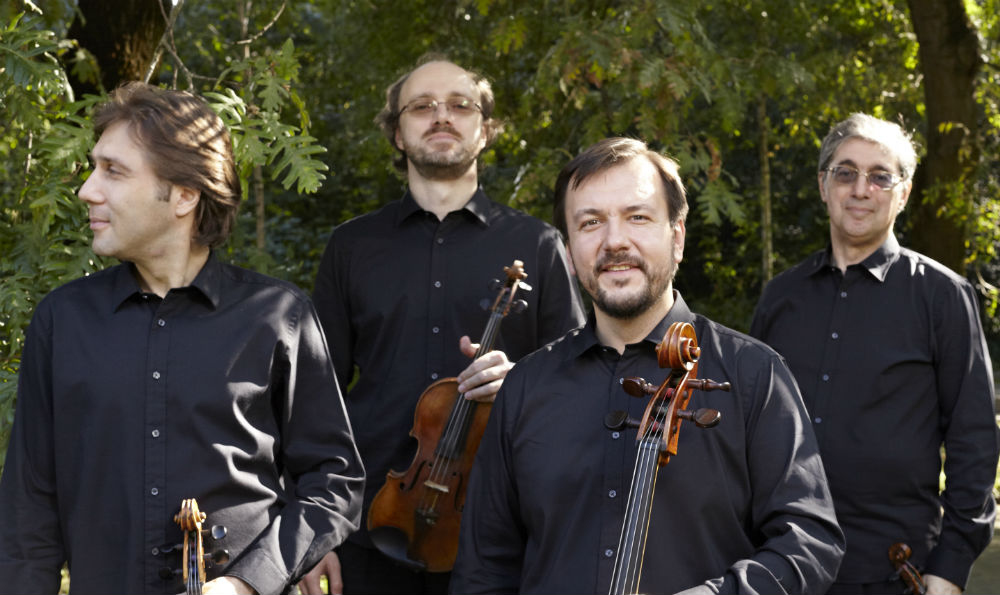Adelaide Town Hall, Thu Oct 9
The combination of the gorgeous Adelaide Town Hall and the great Borodin Quartet was a special occasion for music lovers. Adelaide was privileged to hear the renown Borodin Quartet at the peak of their powers. The Borodin Quartet is nearly 70 years old and has its roots firmly in Russian soil. The Quartet has not been to Australia since 2010 and the audience was full of anticipation to hear the four current musicians Igor Naidin, Ruben Aharonian (first violin), Sergey Lomovsky and Vladimir Balshin (cello). We were treated to a program featuring three of the great composers of music for string quartets: Beethoven, Shostakovich and Schumann.
Beethoven’s String Quartet in F major, Op 18, No. 1 was written when he was a young composer still developing his craft. The piece starts with the sweetness of the violins, light and pure like fresh air. This contrasts with the slower more melancholy second movement; each one is clearly articulated by the Quartet and the differing moods take the audience on a delightful journey. It is playing which allows the instruments to shine individually as well as an ensemble. One of the most enjoyable features was the interplay between the cello and the first violin – communication between the two musicians was wonderful to watch. This piece seems to contain youthful joy as well as a showing a composer flexing his musical muscles to convey a range of emotions and moods.
Shostakovich’s String Quartet No. 11 in F minor, Op 122 with six movements was a stunning piece which left the audience momentarily silenced when it finished. The piece was written later in Shostakovich’s life when he was at a low point. This can be heard in the music which has a much heavier and melancholy mood than the Beethoven composition. The cello sounds mournful and provides a broody undercurrent throughout the piece; the interplay between the themes of the violin and the cello link all six movements beautifully. The heavier mood and undercurrent of something not quite right in the world contrasts with exceptionally sweet violins which creates a sense of poignancy.
This piece is challenging to play and relies on precise timing and ensemble playing as each instrument plays its part in creating the whole. The need for the musicians to be in absolute harmony is critical and the precision of the playing was breathtaking. As each movement flowed into the next we were one with the music – an engrossing experience. The end came as a surprise as it seemed hardly any time had passed.
Technically this piece allowed the musicians to shine and each instrument was used to its full capacity using different techniques to create different moods and tones. The precision, timing and pure musicianship was wonderful to experience.
The final composition, Schumann’s String Quartet No. 14 in D minor D810 ‘Death and The Maiden’ was a fitting finale; full of big sounds, flourishes and a familiar theme. The violins together created such beautiful harmony and again the cello provided a counterpoint. Contrasting moods from light to dirge-like moments kept us completely engaged. At times the music sounded like singing, you could almost put words to the theme. It finished with a grand wild flourish which left the audience momentarily stunned. Was it all over so soon?
The Borodin Quartet creates big bold sounds often surprising the audience as the sound seems much bigger than four musicians. The lush violins and depth of the playing sounds orchestral at times, delicate and minimal at others. It is obvious that these are four very technically able musicians playing music which inspires and feeds the soul. The rapport between the players is visible and adds to the enjoyment of this ensemble.
If you get the chance to hear this marvellous group – take it. You won’t be disappointed and will hear some of the greatest music being played on the planet.
by Taissa Ceric
Borodin Quartet were presented by Musica Viva. For further information, go to www.musicaviva.com.au.
The Clothesline Rating...
Taissa Ceric
Some of the greatest music being played on the planet




